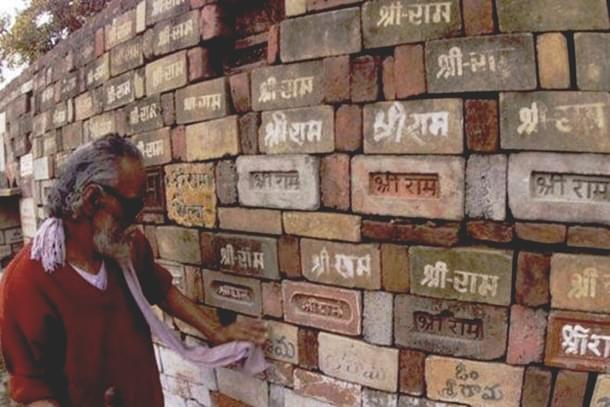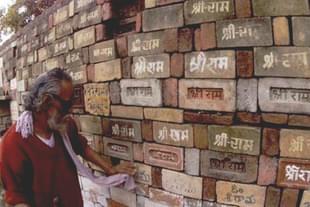Politics
Ayodhya - When The RSS And BJP Joined The Movement
Aravindan Neelakandan
Nov 04, 2023, 03:29 PM | Updated Dec 26, 2023, 05:49 PM IST
Save & read from anywhere!
Bookmark stories for easy access on any device or the Swarajya app.


Why did the 1984 Dharam Sansad of Hindu saints under the Vishwa Hindu Parishad (VHP) choose to liberate Ayodhya before Kashi and Mathura?
To anyone who has been to all three sites, the symbols of occupation are much more evident in the latter two than in Ayodhya.
The scripture-derived answer first.
There are seven holiest-of-holy places for Hindus. Making a pilgrimage to these seven or even one of the seven assures a Hindu liberation – moksha. Hence they are called the Sapta Mokshapuris, the seven centres for liberation.
Between them, they form the boundaries of the sacred geography of Bharat. The famous sloka in Garuda Purana enumerating these seven places starts with Ayodhya:
Ayodhya Mathura Maya Kashi Kanchi Avantika Puri Dvaravati Caiva Saptaite Mokshadayakah
The main reason could have been that while in the cases of Kashi and Mathura, they were built on demolished temples, they were still functional mosques. If Ayodhya, where the site was a functional temple with dome structures above the idols of Ram Lalla, was reclaimed, it could have helped ease the common Indian Muslim psyche in handing over the other site. This goodwill could have been the basis for the return of temples at Kashi and Mathura.
That the RSS expected such an ideal scenario to play out is clear from the 1986 Resolution that its Akhil Bharata Pratinidhi Sabha (AKPS) passed:
The unlocking, after 37 years of closure, of the birth place of Shri Ram-the symbol of utmost devotion of countless crores of our people-has naturally opened the flood-gates of jubilation among all our countrymen and lovers of our culture abroad.... However, the way the Muslim fanatics are going about inciting the Muslim masses is bound to cause grave concern to all lovers of emotional integration of our country.
After citing the famously cliched example of Indonesian Muslims revering Ramayana as part of their culture the resolution further said:
Had Muslims here too welcomed the Court’s decision vis-à-vis Rama Janmabhoomi and honoured Shri Rama as their great ancestor that would have strengthened our emotional bonds. However, those who are trying to tag on the Muslim mind to Babar, a foreign aggressor, just because he happened to belong to the Islamic faith, are only misleading the Muslim masses which can only harm their interests. The Pratinidhi Sabha appeals to the sober and thinking sections among Muslims to come forward to save their masses from falling a prey to separatist mentality and to make them identify themselves with the national mainstream.
Today with the proliferation of the Sita Ram Goel-Ram Swaroop worldview, Hindutva-oriented youth may find the stand of the RSS gullible and naive. But this was in 1986. Most Hindus believed strongly and still do, in the unity of religions. Between national culture and religion they would prefer the former. Naturally, Hindus wanted Muslims to be an integral part of this national culture. Taking an inflexible stance akin to that of Goel and Elst would have marginalized the movement, preventing it from gaining widespread support.
Therefore, in the final analysis, the RSS did strike the right note, presenting the issue in a way that would resonate with the Hindu mindset of the time.
After the Faizabad district magistrate asked the chains be removed and the temple to be opened for Hindus, pan-Islamist forces launched a movement to reclaim the structure. Political parties which were supposed to be secular sided with Islamists in a covert manner.
In 1987, the Babri Masjid Action Committee gave a call to boycott the national Republic Day. This was endorsed by Abdullah Bukhari, the Shahi Imam of Delhi. The Muslim League of Kerala which was then an alliance partner of the ruling Congress also supported the boycott call.
The dispute, which initially had the potential to be resolved locally and foster goodwill between Hindus and Muslims across India, was turned into a confrontational struggle by Islamist groups. In a sense, they were asserting that the destruction of temples shouldn't be viewed as wrongdoings committed by medieval rulers. Instead, it was a clear expression of the Islamist goal to establish the dominance of 'true religion' over the idol-worshipping polytheist Hindus.
In 1987, the RSS resolution on the Shri Rama Janmabhoomi issue stated that the government's yielding to Islamist fundamentalist pressures had emboldened them to boycott Republic Day. It's worth noting that the RSS saw this boycott as a sign of Muslims aligning themselves with Babar, a foreign aggressor, rather than with Shri Rama, ‘the noblest symbol of our national heritage.’
Thus, the appeasement of Islamists in emboldened political Islamism which in turn contributed to further radicalisation of Muslim youths. They were now networking with global Islamist forces on an unprecedented scale.
At that time, Lal Krishna Advani, who was the President of BJP, recognized the assertive message behind the increasingly firm stance of political Islam across India. Despite Rajiv Gandhi's government having a strong majority, it had shown a willingness to yield to Pan-Islamism, even if it meant the latter disrespecting India's national honor by boycotting Republic Day. Advani believed that the issue was no longer just a concern for the religious leaders (Sants). It had become a national matter.
In June 1989, the National Executive Meeting took place at Rotary Bhavan in Palampur, Himachal Pradesh. It was here that L.K. Advani integrated the Ayodhya issue into BJP's political agenda. The resolution stated: 'The sentiments of the people must be respected, and Ram Janmastan handed over to the Hindus – if possible through a negotiated settlement, or else by legislation.' The Palampur resolution marked the beginning of a nationwide movement, both politically and culturally, to unify Hindus.
In addition, the Vishwa Hindu Parishad (VHP) announced a large-scale initiative to gather bricks from every corner of India. These bricks were made from soil representing nearly every Indian village, sanctified through local rituals, and then ceremoniously carried in a procession to Ayodhya.
The Rashtriya Swayamsevak Sangh (RSS) also voiced its support for the movement. The resolution passed at the highest body of the RSS, the 'Akhil Bharatiya Karyakari Mandal' (ABKM), began by acknowledging "some Muslim organizations' efforts to clear the remnants of the so-called mosque on the Rama-Janma Bhumisthan and vacate it for the proposed temple of Lord Shri Rama."
It further urged other Muslims to follow suit, thereby demonstrating their brotherly sentiments towards Hindus.
This marked the explicit organizational participation of the RSS in the Ayodhya movement, for the first time.
The RSS resolutions on Ayodhya appeared to be driven by the following logic:
- A fragile Hindu society and a politically motivated, pseudo-secular government catering to vote banks would have eventually lead to all Indians, regardless of their religion, becoming victims of the inevitable rise of pan-Islamic terrorism.
- Therefore, Hindu unity was imperative. The Ayodhya movement was a means to achieve this goal.
- It had to be pursued with a mindset of clearly understanding Pan-Islamist extremism, and not with animosity towards Muslims.
The complete submission of the Government to fundamentalists concerning the Muslim women's bill, the growing challenges faced by Kashmiri Hindus, the indifference of the Government that empowered Islamist terrorism, and the united opposition of most political factions against Hindus in the case of Shri Rama Janmabhoomi - all these factors converged, leaving a powerful impression on the collective Hindu consciousness.
1989 was also the centenary year of Dr. Kesav Baliram Hedgewar – the founder of the RSS. The organisation was conducting mass outreach programmes in almost every taluk of India. Simultaneously, the RSS asked its cadre to involve itself in a pan-Indian movement for the Rama temple.
At that time, it was estimated that the RSS had around 300,000 Shakas (branches) across India. This widespread network provided a strong foundation for the burgeoning movement.
It was a well-balanced blend. It included local contributions, both tangible— with the soil from the village—and emotional as the bricks were offered pooja. They were then taken in a procession, promoting social awareness and unity.
Following the freedom movement, it was the Ayodhya movement which emerged as the largest and most widespread socio-political struggle.
This is the second piece in the 'Ayodhya 2024' series that Aravindan Neelakandan is writing in the build-up to the inauguration of the Shri Rama Janmabhoomi temple. We will be publishing one article every week. You can read rest of the pieces in the series here.





